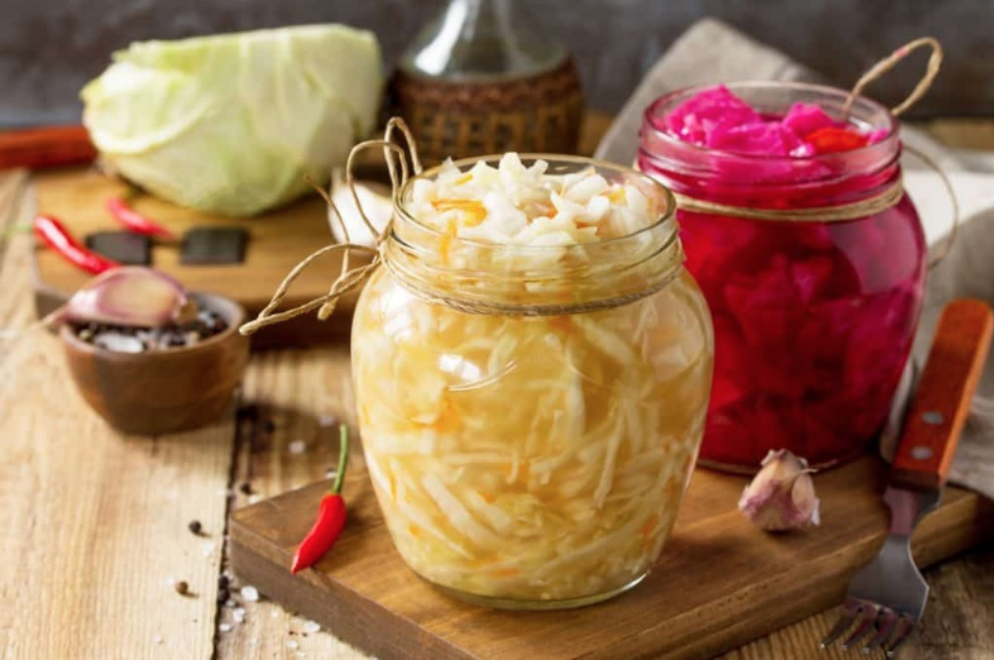Basic Sauerkraut

Prep Time
30 minutes
Prep Notes
Feeding the healthy bacteria that live in your gut is important to your overall health. So learning how to make this basic recipe is easy and fun. It takes time for your kraut to ferment and you can make it with or without an added culture. You can make small batches or 1 big one and divide it after it starts fermenting.
Cooking Time
0 minutes
Yields
One to 2 gallons depending on size of container
Ingredients
- 1 or 2 Cabbage (green, red, or Napa – try all 3 individually or together)
- Root vegetable (carrots, dikon radish, beets, others) these can be sliced, grated, or julienned
- Flavor enhancers – onion (red or yellow), peppers (sweet or jalapeno), Garlic (whole or chopped), Ginger (whole slices or chopped), Tumeric root (shredded), Dill weed, feel free to add several of these or just one or two. It all depends on the flavor you’re looking for.
- Additional Spices – Cumin, Celtic Sea Salt or Real Salt, Ground Tumeric, Dill, other herbs. Again this all depends of what you like the flavor of and
- ½ cup of whey from Kefir or can get a culture packet from Culturedfoodlife.com
MATERIALS
Container(s) to ferment your kraut in.
1 GallonJar with Airlock Lid – optional, you can use large mason jars, large pickling crocks with a plate or round wooden piece to put on top locking out the air.
Directions
- If using the starter culture, stir together the culture and 1/2 cup of water. Let the mixture sit while you prepare the ingredients—around 10 minutes. If using kefir whey, add it when the recipe calls for culture.
- Remove outer leaves of cabbage. You can use these later when you put your kraut in the fermenting container. The larger the container the more leaves to save out. Cut out the core on the cabbage.
- Shred cabbage into desired length. You can use a food processor or by hand. You can chop it finely or in thicker pieces it's up to you!
- Add your cabbage to a large bowl and add salt and toss with cabbage to combine evenly. When you toss it is desired to do this using your hands so you can crush or squeeze the cabbage and begin the breakdown process.
- Add in extra veggies, fruit or seasoning if desired at this point and toss together to evenly combine. Again, best to do this with your bare hands.
- Add the CuttingEdge Cultures or kefir whey to the shredded veggies and toss again to spread it evenly.
- Pack cabbage into a canning jars or pickling crocks, pushing the shredded veggies down with enough pressure to make the natural juices begin to rise to the top. Make sure you save about two inches at the top of the jar for the cabbage to expand. Save about 3-4 inches in a large pickling crock.
- Once you have filled the jars or crock with the vegetables you should have produced a bit of liquid on the top. Try and push the vegetables under this liquid. Cover the vegetables with the leaves removed from your cabbage at the beginning. Push these leaves into the liquid on top. If you feel there is not enough you can add fresh spring water (NO TAP WATER, chlorine and other chemicals will kill the bacteria needed for fermentation).Leave 2 to 3 inches of space at the top of the jar for kraut to expand.
- Place secure lids or airlocks on jars. Press round wooden board or ceramic plate into the crocks and place a weight or large rocks on top of the board/plate to keep the veggies submerged in the watery liquid. Set in a cool place, out of sunlight for 6 to 7 days. After 6 days remove the leaves and taste them. If they're tart tasting they're ready, and you can eat them or place them in the refrigerator.
Notes
You can check the vegetables every day to make sure they are fully submerged in the water. If they have risen above the water, simply push them down so they are fully covered by the water or add more water to cover. If any white spots formed because the veggies rose above the water, do not worry. Remember, this isn’t harmful. Just scoop out the vegetables that have the white spots on them and push the rest back under the water. These can last at least 9 months or longer in your fridge.
Sauerkraut is a condiment and can be served with corn chips like a salsa or with meat dishes, on hotdogs and hamburgers or with your favorite green salad.
